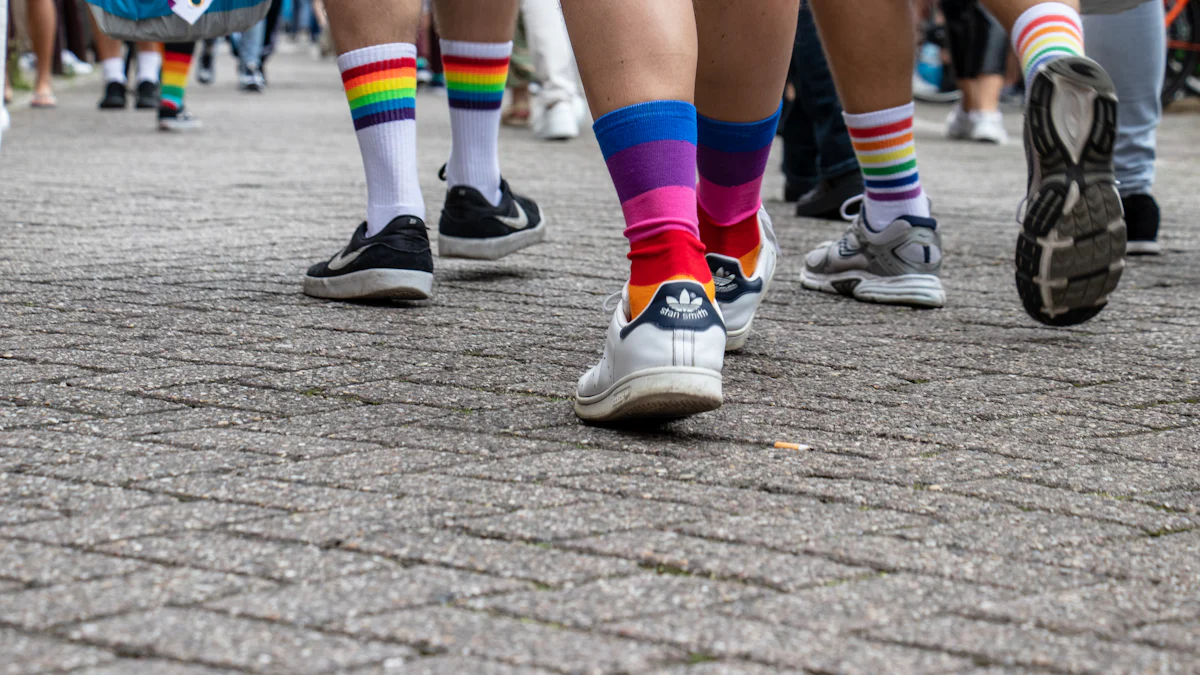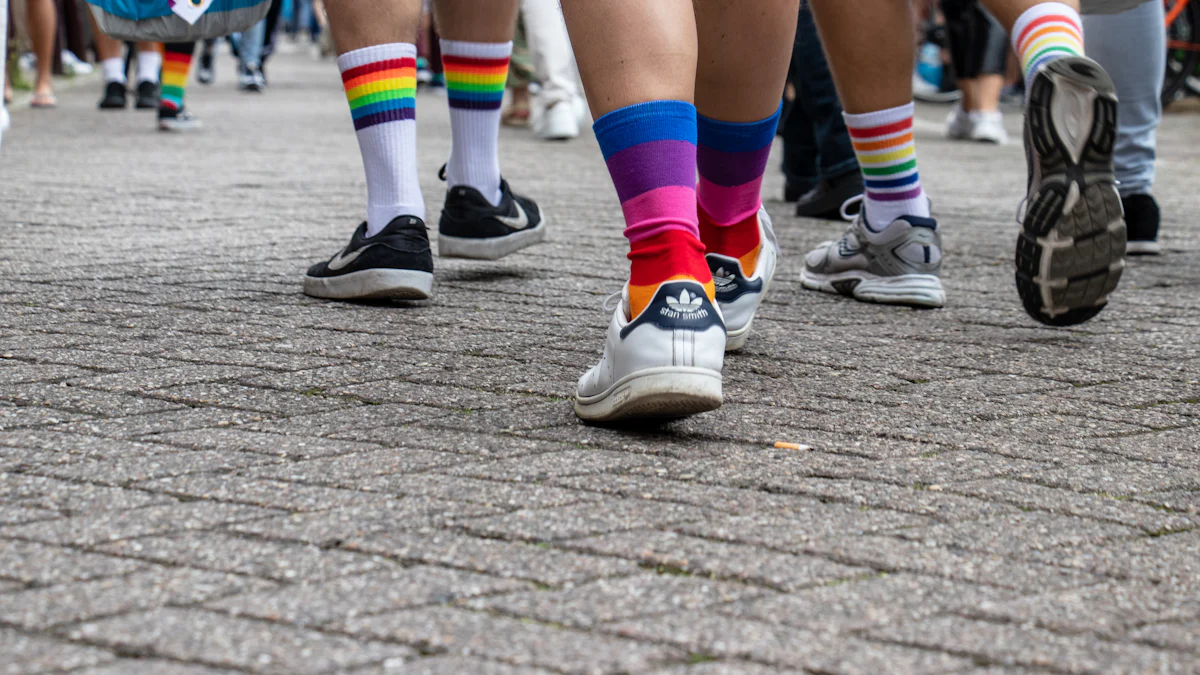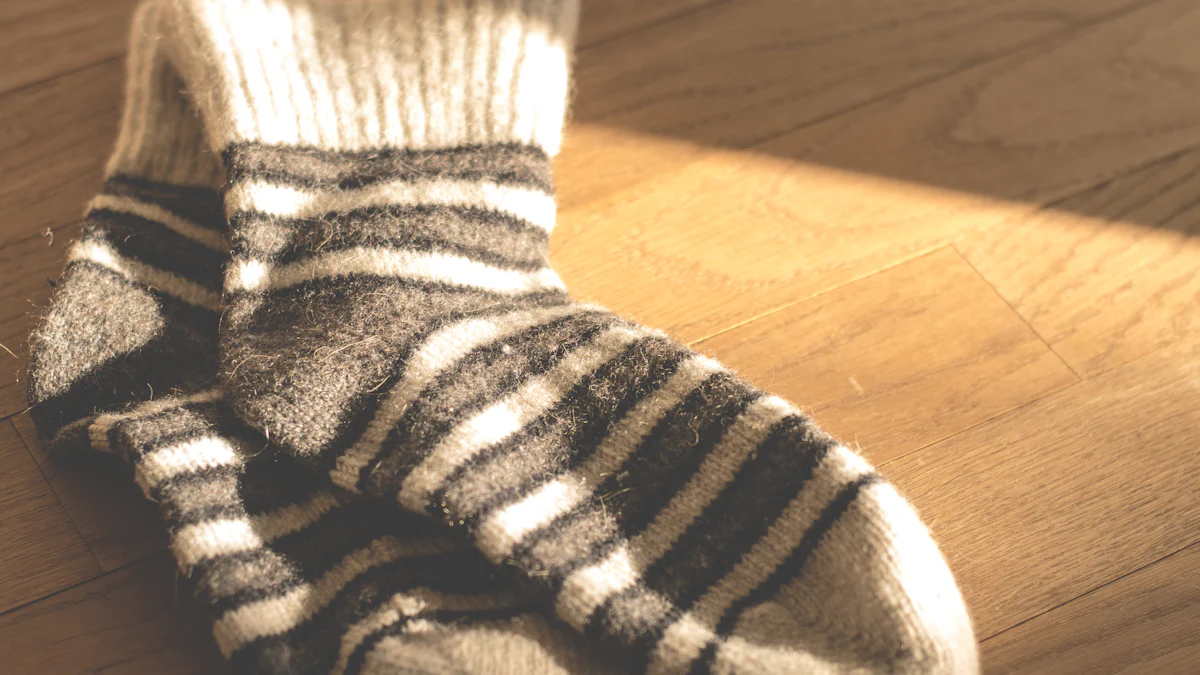
Choosing the right running socks can make or break a runner’s experience. The focus for 2024 shines on cotton running socks, which offer unmatched comfort and breathability. These socks cater to various needs, from blister prevention to cold-weather insulation. Cotton running socks dominate the market due to their popularity and inherent qualities like moisture absorption. Runners can find options that suit every preference, ensuring a perfect fit for any running condition.
Best Overall Cotton Running Socks

Features and Benefits
Material and Comfort
The best overall cotton running socks use high-quality cotton. This material provides a soft, plush feel against the skin. Runners experience unmatched comfort during long runs. The breathability of cotton keeps feet cool and dry. This feature helps prevent discomfort and blisters.
Durability and Longevity
Durability stands out as a key benefit. These socks withstand frequent washing without losing shape. High-quality stitching ensures long-lasting wear. Runners can rely on these socks for many miles. The investment in durable socks saves money over time.
Pros and Cons
Advantages
- Comfort: The softness of cotton offers superior comfort.
- Breathability: Cotton allows air to circulate, keeping feet dry.
- Durability: High-quality construction ensures longevity.
- Moisture Absorption: Cotton absorbs sweat effectively.
Disadvantages
- Drying Time: Cotton takes longer to dry compared to synthetic materials.
- Weight: Cotton socks may feel heavier when wet.
- Shrinkage: Improper washing can cause shrinkage.
Personal Recommendation
Why it’s the best overall
The best overall cotton running socks excel in comfort and durability. Runners appreciate the plush feel and breathability. The socks maintain their shape and performance after many washes. These qualities make them a top choice for any runner. The combination of comfort and longevity justifies the investment.
Best Budget Cotton Running Socks
Features and Benefits
Affordability
Budget-conscious runners will find these cotton running socks a perfect match. The price point remains accessible without sacrificing essential features. Many brands offer multi-packs, providing more value for the money. Affordable options ensure runners don’t break the bank while still enjoying quality socks.
Quality and Performance
Despite the lower price, these socks deliver impressive performance. High-quality cotton ensures comfort during runs. The material feels soft against the skin, reducing irritation. Breathability remains a key feature, keeping feet cool and dry. These socks also provide adequate cushioning to support long-distance runs.
Pros and Cons
Advantages
- Cost-Effective: Lower price without compromising on essential features.
- Comfortable: Soft cotton material enhances comfort.
- Breathable: Keeps feet cool and dry during runs.
- Value Packs: Multi-pack options offer great value.
Disadvantages
- Durability: May not last as long as premium options.
- Limited Features: Fewer advanced features compared to higher-end socks.
- Shrinkage Risk: Improper washing can cause shrinkage.
Personal Recommendation
Best value for money
For runners seeking value, these budget-friendly cotton running socks stand out. The combination of affordability and performance makes them an excellent choice. Runners enjoy comfort and breathability without overspending. Multi-pack options provide even more savings. These socks offer the best value for money, making them a smart investment for any runner.
Best Cotton Running Socks for Long-Distance Running
Features and Benefits
Cushioning and Support
Long-distance runners need exceptional cushioning. Cotton running socks provide that plush feel underfoot. The padding absorbs impact, reducing strain on feet. This support helps prevent injuries during extended runs. High-quality cotton ensures a soft, comfortable experience.
Breathability
Breathability remains crucial for long-distance running. Cotton running socks excel in this area. The material allows air to circulate freely. This ventilation keeps feet cool and dry. Moisture-wicking properties help manage sweat effectively. Runners stay comfortable even on the longest routes.
Pros and Cons
Advantages
- Comfort: Soft cotton material enhances comfort.
- Support: Extra cushioning provides necessary support.
- Breathability: Air circulation keeps feet cool.
- Moisture Management: Effective sweat control.
Disadvantages
- Drying Time: Cotton takes longer to dry.
- Weight: Wet socks may feel heavier.
- Shrinkage Risk: Improper washing can cause shrinkage.
Personal Recommendation
Why it’s ideal for long-distance
Cotton running socks stand out for long-distance running. The combination of cushioning and breathability makes them perfect. Runners appreciate the soft, supportive feel. The moisture management keeps feet dry and comfortable. Investing in high-quality cotton running socks enhances the long-distance running experience.
Best Cotton Running Socks for Cold Weather

Features and Benefits
Insulation
Cold weather demands socks that keep feet warm. Smartwool Run Targeted Cushion Running Socks excel in insulation. Made from merino wool, these socks trap heat effectively. Runners enjoy warmth without sacrificing comfort. The thicker material provides a cozy barrier against the cold.
Swiftwick Pursuit Four also shines in cold conditions. These socks feature a thicker design, perfect for chilly runs. The added insulation ensures feet stay toasty. Runners appreciate the extra warmth during winter workouts.
Moisture-Wicking
Moisture management remains crucial in cold weather. Wet feet can lead to discomfort and blisters. Darn Tough Micro Crew Ultra-Lightweight Running Sock offers excellent moisture-wicking properties. The wool blend material pulls sweat away from the skin. Feet stay dry and comfortable, even during intense runs.
Paka Crew Socks also perform well in moisture control. The thicker fabric absorbs sweat efficiently. Runners experience fewer issues with dampness. These socks pair well with roomier trail running shoes, enhancing overall comfort.
Pros and Cons
Advantages
- Warmth: Thicker materials provide excellent insulation.
- Comfort: Soft fabrics enhance the running experience.
- Moisture Control: Effective sweat management keeps feet dry.
- Versatility: Suitable for various cold-weather conditions.
Disadvantages
- Bulkiness: Thicker socks may feel bulky in tighter shoes.
- Drying Time: Heavier materials take longer to dry.
- Weight: Wet socks may feel heavier during runs.
Personal Recommendation
Best for winter runs
For winter runs, Smartwool Run Targeted Cushion Running Socks stand out. The merino wool provides unmatched warmth and comfort. Runners appreciate the moisture-wicking capabilities. These socks keep feet dry and cozy in cold conditions. Investing in high-quality cotton running socks enhances the winter running experience.
Best Cotton Running Socks for Blister Prevention
Features and Benefits
Anti-Blister Technology
Blisters can ruin a good run. The best cotton running socks for blister prevention use advanced technology to combat this issue. GoWith’s Anti Blister ankle running socks excel in this area. These socks feature seamless construction, reducing friction points. This design minimizes the risk of blisters forming during runs. Moisture-wicking fibers like Olefin move sweat away from the skin. This keeps feet dry and comfortable, further preventing blisters.
Fit and Comfort
Proper fit plays a crucial role in blister prevention. Well-fitted socks reduce friction and pressure on the feet. Morgan Wolf, a running expert, emphasizes the importance of choosing socks that are not too tight or too loose. Cotton running socks should hug the foot snugly without causing discomfort. Breathable materials enhance comfort by allowing air to circulate. This keeps feet cool and dry, reducing the likelihood of chafing and overheating.
Pros and Cons
Advantages
- Blister Prevention: Advanced technology reduces friction and moisture.
- Comfort: Proper fit ensures a snug, comfortable feel.
- Breathability: Air circulation keeps feet cool and dry.
- Moisture-Wicking: Fibers like Olefin manage sweat effectively.
Disadvantages
- Drying Time: Cotton takes longer to dry compared to synthetic materials.
- Weight: Wet socks may feel heavier during runs.
- Shrinkage Risk: Improper washing can cause shrinkage.
Personal Recommendation
Why it’s best for blister prevention
For blister prevention, GoWith’s Anti Blister ankle running socks stand out. The seamless construction and moisture-wicking fibers provide excellent protection. Runners appreciate the snug fit and breathability. These socks keep feet dry and comfortable, reducing the risk of blisters. Investing in high-quality cotton running socks enhances the running experience by preventing painful blisters.
What to Consider When Buying Cotton Running Socks
Material Quality
Importance of High-Quality Cotton
High-quality cotton ensures a comfortable running experience. Premium cotton offers a soft, plush feel against the skin. This material provides excellent breathability, keeping feet cool and dry. High-quality cotton also absorbs moisture effectively, reducing the risk of blisters. Investing in socks made from superior cotton enhances overall comfort during runs.
Fit and Comfort
Finding the Right Size
Proper fit plays a crucial role in comfort. Socks that fit well reduce friction and prevent blisters. Runners should choose socks that hug the foot snugly without causing discomfort. A good fit ensures that the sock stays in place during runs. Breathable materials enhance comfort by allowing air to circulate. This keeps feet cool and dry, reducing the likelihood of chafing.
Durability
How to Ensure Longevity
Durability is essential for long-lasting wear. High-quality stitching ensures that socks withstand frequent washing. Reinforced heel and toe areas add extra durability. For example, the Darn Tough Run Ultra-Light Cushion Quarter Running Sock features reinforced areas for long-lasting wear. Proper care, such as washing in cold water and air drying, helps maintain the sock’s shape and performance. Investing in durable socks saves money over time, providing reliable performance for many miles.
How We Tested the Socks
Testing Criteria
Comfort and Fit
Comfort and fit play a crucial role in evaluating running socks. Testers from OutdoorGearLab wore each pair during various activities. These activities included long walks, runs, and workouts. The goal was to assess how well the socks cushioned the feet. Proper fit ensures that the socks stay in place without causing discomfort. The testers paid close attention to any areas that might cause blisters or irritation.
Performance in Different Conditions
Performance in different conditions is vital for running socks. The expert team at Garage Gym Reviews tested the socks in various environments. These environments ranged from hot and humid to cold and wet. The socks needed to maintain their breathability and moisture-wicking capabilities. The testers also evaluated how well the socks managed sweat. This testing ensured that the socks kept feet dry and comfortable regardless of the weather.
Testing Process
Real-World Testing
Real-world testing involved wearing the socks during actual runs and workouts. Testers from iRunFar ranked the socks based on breathability, moisture transfer, cushioning, protection, and durability. Each tester provided feedback on how the socks performed during different activities. The feedback helped identify any strengths or weaknesses in the socks’ design. This hands-on approach ensured that the reviews were based on real experiences.
Lab Testing
Lab testing provided a controlled environment to evaluate specific features. Experienced testers at Runner’s World conducted vertical moisture-wicking tests. These tests measured how quickly the socks moved moisture away from the skin. The lab tests also assessed the durability of the socks after multiple washes. High-quality stitching and reinforced areas were put to the test. The combination of real-world and lab testing provided a comprehensive evaluation of each sock’s performance.
FAQs
Common Questions
Are cotton socks good for running?
Cotton socks offer comfort and breathability. However, cotton retains moisture. Wet feet can lead to blisters and discomfort. Moisture-wicking fabrics work better for running. These materials keep feet dry and comfortable.
How often should I replace my running socks?
Running socks wear out over time. Frequent use and washing reduce their effectiveness. Replace running socks every six months. Look for signs of wear and tear. Holes, thinning fabric, and loss of elasticity indicate replacement time.
Expert Answers
Insights from Running Experts
Morgan Wolf, Product Manager at Swiftwick, suggests finding socks that fit well and incorporate materials that work well for your feet. “For all runs, runners should look for moisture-wicking, well-fitted socks to prevent blisters, which are often caused by the combination of friction, pressure, and moisture. Socks, like shoes, are sized to your foot, and having an improper fit may lead to blisters, so make sure that the socks you choose are not too tight or too loose,” Wolf explains. “In addition, look for breathable, moisture-wicking fibers, such as Olefin, which moves moisture away from your skin, greatly reducing the likelihood of chafing and overheating your feet.”
Proper fit and material choice enhance running comfort. Moisture-wicking fibers like Olefin help manage sweat. Breathable socks prevent overheating and chafing. Well-fitted socks reduce friction and pressure.
The top picks for cotton running socks in 2024 offer a range of options for every runner. Each sock excels in different areas, from overall comfort to blister prevention. Choosing the right pair involves considering personal needs and preferences. High-quality cotton ensures a comfortable and durable experience. Runners should prioritize fit, breathability, and moisture management. Investing in the best socks enhances the running journey, providing both comfort and performance.
See Also
Discovering the Range of Socks for Males and Females

